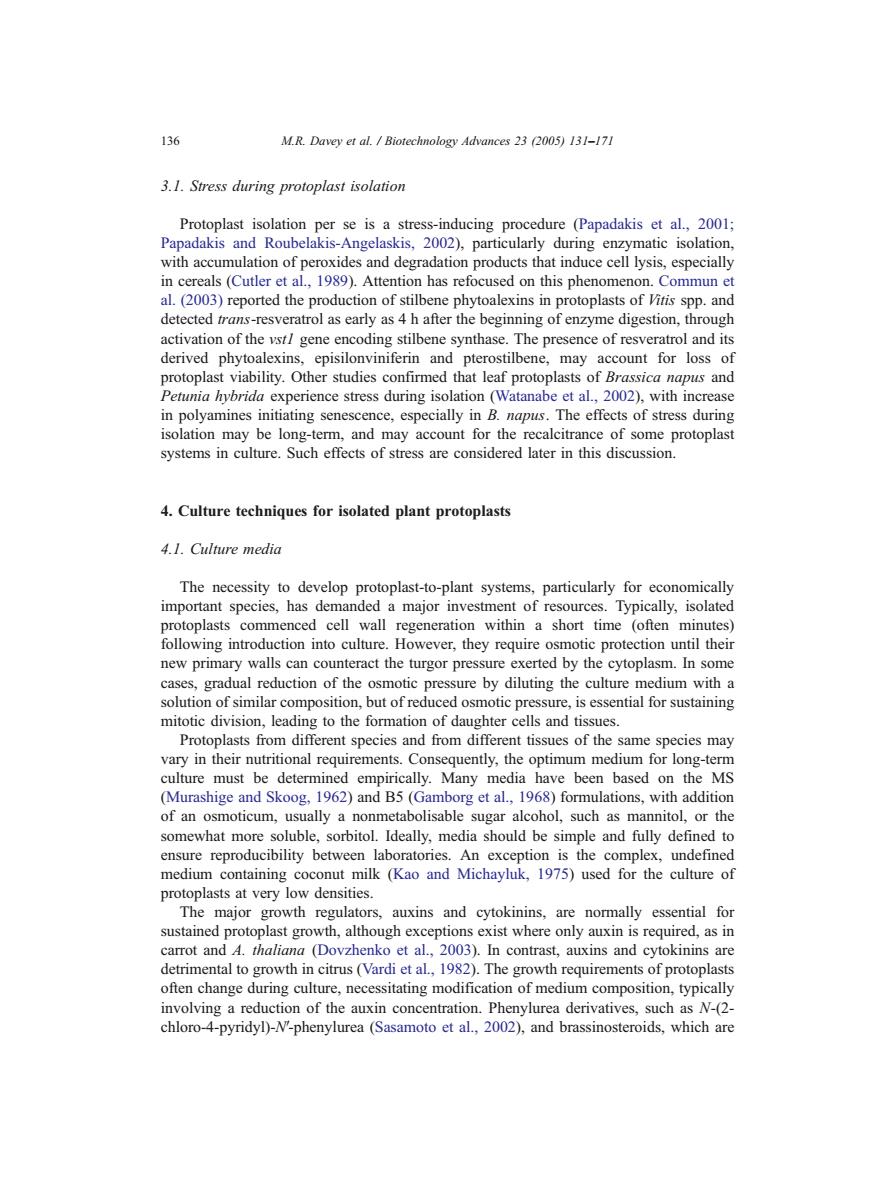正在加载图片...

136 M.R.Davey et al.Biotechnology Advances 23 (2005)131-171 3.1.Stress during protoplast isolation Protoplast isolation per se is a stress-inducing procedure (Papadakis et al.,2001; Papadakis and Roubelakis-Angelaskis,2002),particularly during enzymatic isolation, with accumulation of peroxides and degradation products that induce cell lysis,especially in cereals(Cutler et al.,1989).Attention has refocused on this phenomenon.Commun et al.(2003)reported the production of stilbene phytoalexins in protoplasts of Vitis spp.and detected trans-resveratrol as early as 4 h after the beginning of enzyme digestion,through activation of the vst/gene encoding stilbene synthase.The presence of resveratrol and its derived phytoalexins,episilonviniferin and pterostilbene,may account for loss of protoplast viability.Other studies confirmed that leaf protoplasts of Brassica napus and Petunia hybrida experience stress during isolation (Watanabe et al.,2002),with increase in polyamines initiating senescence,especially in B.napus.The effects of stress during isolation may be long-term,and may account for the recalcitrance of some protoplast systems in culture.Such effects of stress are considered later in this discussion. 4.Culture techniques for isolated plant protoplasts 4.1.Culture media The necessity to develop protoplast-to-plant systems,particularly for economically important species,has demanded a major investment of resources.Typically,isolated protoplasts commenced cell wall regeneration within a short time (often minutes) following introduction into culture.However,they require osmotic protection until their new primary walls can counteract the turgor pressure exerted by the cytoplasm.In some cases,gradual reduction of the osmotic pressure by diluting the culture medium with a solution of similar composition,but of reduced osmotic pressure,is essential for sustaining mitotic division,leading to the formation of daughter cells and tissues. Protoplasts from different species and from different tissues of the same species may vary in their nutritional requirements.Consequently,the optimum medium for long-term culture must be determined empirically.Many media have been based on the MS (Murashige and Skoog,1962)and B5(Gamborg et al.,1968)formulations,with addition of an osmoticum,usually a nonmetabolisable sugar alcohol,such as mannitol,or the somewhat more soluble,sorbitol.Ideally,media should be simple and fully defined to ensure reproducibility between laboratories.An exception is the complex,undefined medium containing coconut milk (Kao and Michayluk,1975)used for the culture of protoplasts at very low densities. The major growth regulators,auxins and cytokinins,are normally essential for sustained protoplast growth,although exceptions exist where only auxin is required,as in carrot and A.thaliana (Dovzhenko et al.,2003).In contrast,auxins and cytokinins are detrimental to growth in citrus(Vardi et al.,1982).The growth requirements of protoplasts often change during culture,necessitating modification of medium composition,typically involving a reduction of the auxin concentration.Phenylurea derivatives,such as N-(2- chloro-4-pyridyl)-N-phenylurea(Sasamoto et al.,2002),and brassinosteroids,which are3.1. Stress during protoplast isolation Protoplast isolation per se is a stress-inducing procedure (Papadakis et al., 2001; Papadakis and Roubelakis-Angelaskis, 2002), particularly during enzymatic isolation, with accumulation of peroxides and degradation products that induce cell lysis, especially in cereals (Cutler et al., 1989). Attention has refocused on this phenomenon. Commun et al. (2003) reported the production of stilbene phytoalexins in protoplasts of Vitis spp. and detected trans-resveratrol as early as 4 h after the beginning of enzyme digestion, through activation of the vst1 gene encoding stilbene synthase. The presence of resveratrol and its derived phytoalexins, episilonviniferin and pterostilbene, may account for loss of protoplast viability. Other studies confirmed that leaf protoplasts of Brassica napus and Petunia hybrida experience stress during isolation (Watanabe et al., 2002), with increase in polyamines initiating senescence, especially in B. napus. The effects of stress during isolation may be long-term, and may account for the recalcitrance of some protoplast systems in culture. Such effects of stress are considered later in this discussion. 4. Culture techniques for isolated plant protoplasts 4.1. Culture media The necessity to develop protoplast-to-plant systems, particularly for economically important species, has demanded a major investment of resources. Typically, isolated protoplasts commenced cell wall regeneration within a short time (often minutes) following introduction into culture. However, they require osmotic protection until their new primary walls can counteract the turgor pressure exerted by the cytoplasm. In some cases, gradual reduction of the osmotic pressure by diluting the culture medium with a solution of similar composition, but of reduced osmotic pressure, is essential for sustaining mitotic division, leading to the formation of daughter cells and tissues. Protoplasts from different species and from different tissues of the same species may vary in their nutritional requirements. Consequently, the optimum medium for long-term culture must be determined empirically. Many media have been based on the MS (Murashige and Skoog, 1962) and B5 (Gamborg et al., 1968) formulations, with addition of an osmoticum, usually a nonmetabolisable sugar alcohol, such as mannitol, or the somewhat more soluble, sorbitol. Ideally, media should be simple and fully defined to ensure reproducibility between laboratories. An exception is the complex, undefined medium containing coconut milk (Kao and Michayluk, 1975) used for the culture of protoplasts at very low densities. The major growth regulators, auxins and cytokinins, are normally essential for sustained protoplast growth, although exceptions exist where only auxin is required, as in carrot and A. thaliana (Dovzhenko et al., 2003). In contrast, auxins and cytokinins are detrimental to growth in citrus (Vardi et al., 1982). The growth requirements of protoplasts often change during culture, necessitating modification of medium composition, typically involving a reduction of the auxin concentration. Phenylurea derivatives, such as N-(2- chloro-4-pyridyl)-NV-phenylurea (Sasamoto et al., 2002), and brassinosteroids, which are 136 M.R. Davey et al. / Biotechnology Advances 23 (2005) 131–171